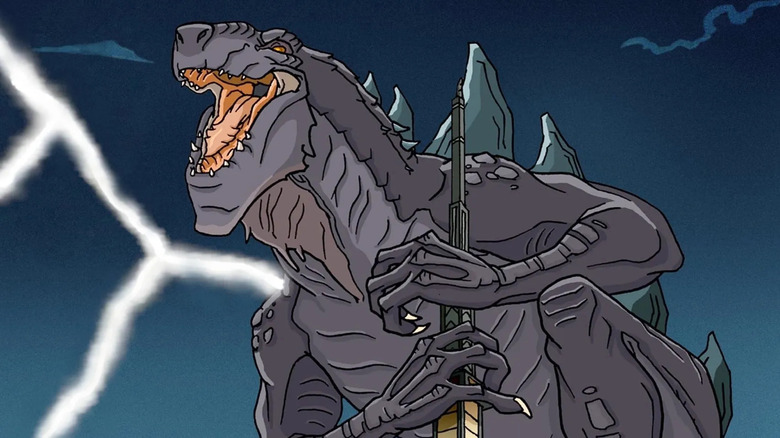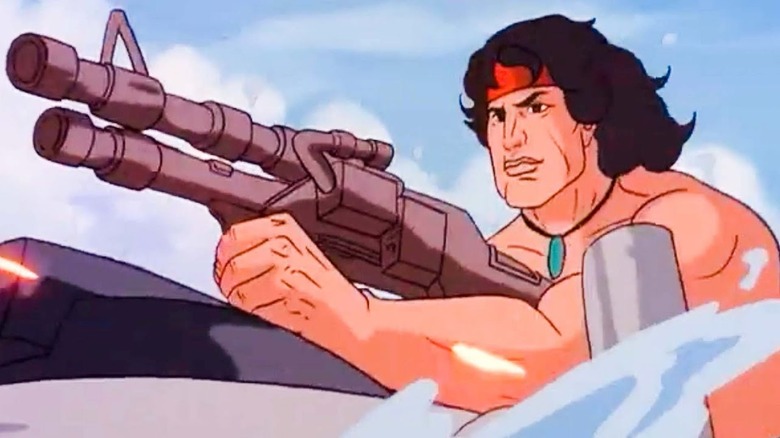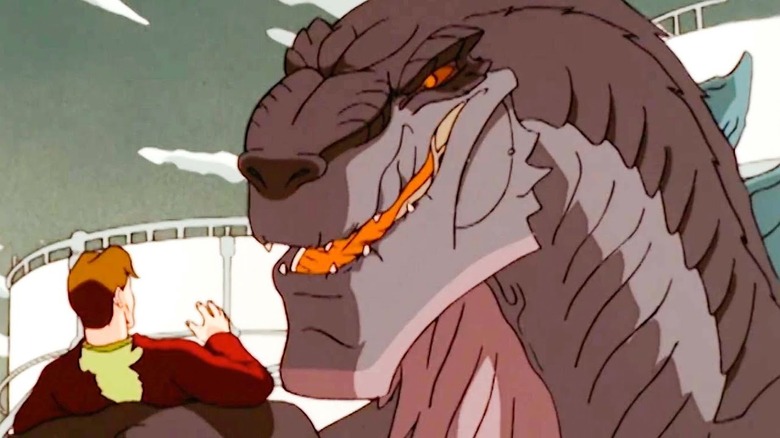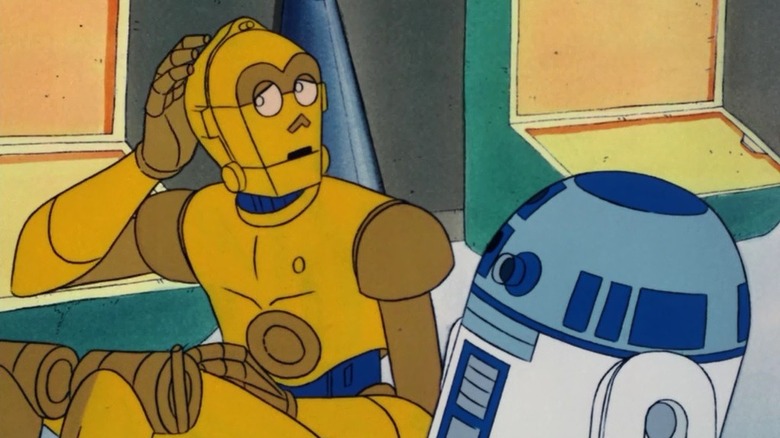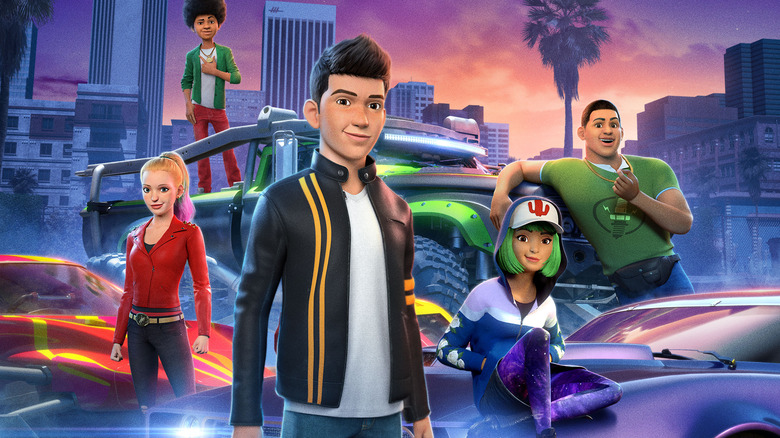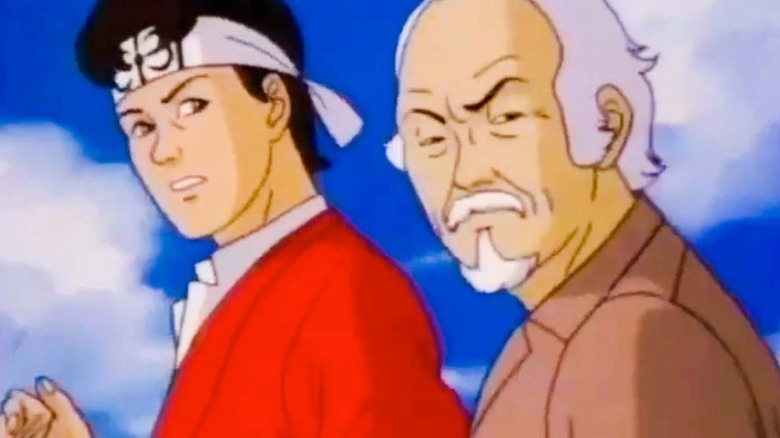5 Cartoon Series Based On Movies That You Totally Forgot Existed
Making cartoon spin-offs of major motion pictures is a long and proud tradition in Hollywood, even though the resulting shows aren't often ones to be proud of. In the 1980s and '90s in particular, tie-in cartoons and toy lines became the de facto business model for any movie kids might get excited about. Robots? Monsters? Even a little bit of karate? That was enough to launch a media empire. "Bill & Ted" got a show. "Back to the Future" got a show. Heck, even "Attack of the Killer Tomatoes" got a show.
A handful of higher-quality examples remain in the public consciousness today, kept afloat mostly by nostalgia. It's hard to imagine "Ghostbusters" becoming a decades-long merchandising behemoth without the five-year run of "The Real Ghostbusters." Later examples like the "Ace Ventura: Pet Detective" cartoon kept the tradition going after the era of "Transformers" and "G.I. Joe" ended. These days, plenty of animated series are still spun off from popular movies, though they tend to pop up more on streaming platforms than the old Saturday morning model. Of course, the rise of the transmedia franchise has blurred the lines between "spin-off for kids" and "yet another piece of content."
To commemorate this most advantageous of media, let's look back at some less-famous cartoon series based on movies that you likely forgot even existed.
Rambo: The Force of Freedom
Some of the 1980s' cartoon spin-offs are real head-scratchers today. For instance, "RoboCop" is a brutally violent satire of America's militarized police forces and systemic corruption at large, and it got not one, but two different animated series in a span of just five years. The logic is odd, but it's also kind of understandable from a studio executive position. Kids love robots, right? They love action? Great, RoboCop is for kids now.
You know what else kids love? "G.I. Joe." And hey, those Rambo movies did pretty well, didn't they? Sylvester Stallone played Rocky, so he's basically a perfect role model for children. Never mind that "First Blood" is a movie about the horrors of war and PTSD, or that the entire Rambo franchise is famous for its extreme violence.
"Rambo: The Force of Freedom" is about as blatant of a "G.I. Joe" ripoff as you could make without getting slapped with a copyright infringement lawsuit. Remember COBRA? Well, they're SAVAGE now. Remember Stallone? He's not here. Instead, John Rambo was voiced by prolific voice actor Neil Ross, who'd previously played various characters on — you guessed it — "G.I. Joe."
While this one may not earn any awards for positive impact on TV history (or for originality in general), it's a perfect example of the quintessential tie-in cartoon from the mid-'80s, and for that reason, there's still some fun to be had here.
Godzilla: The Series
At face value, "Let's make a cartoon about Godzilla" doesn't sound so far-fetched. Toho's expansive kaiju roster lends itself naturally to a monster-of-the-week format, and let's face it, kids love the big lizard. So what makes 1998's "Godzilla: The Series" such a baffling and forgettable entry in the franchise? Well, the show doesn't really have anything to do with the Godzilla we all know and love. Instead, it's a direct sequel spin-off to the critically panned 1998 American "Godzilla," starring Matthew Broderick, Jean Reno, and Maria Pitillo.
These days, it's widely accepted that America's first attempt at a big-budget Godzilla film was an unmitigated disaster, which makes it all the more surprising that the ensuing cartoon lasted two whole seasons. It's a far more competent cartoon than the accompanying movie is a movie, and while none of the film's stars returned, the cast included big names like Ron Perlman, Joe Pantoliano, Paget Brewster, and legendary voice actor Frank Welker as Godzilla himself.
The premise is classic Saturday morning camo: A surviving Godzilla baby hatches, imprints on Dr. Nick Tatopoulos (Ian Ziering), and travels the globe with a special human task force battling other dangerous mutated creatures. The sad part? None of Toho's other kaiju make it in. Instead, Godzilla is left battling writers room chaff like "King Cobra" and "Crustaceous Rex."
It wasn't the first Godzilla animated series, and it wasn't the last, but it is perhaps the most bizarre simply because of its heritage.
Star Wars: Droids and Star Wars: Ewoks
These days, Star Wars is as much an animated franchise as it is a live-action one. Lucasfilm's animation division has had a stellar track record ever since the beginning of "Star Wars: The Clone Wars," with ensuing shows like "Rebels," "The Bad Batch," and "Tales of the Jedi" all earning high marks from critics and fans. And who could forget Genndy Tartakovsky's gorgeous contribution in the early 2000s?
Long before any of those shows, Star Wars dipped its toes into the flooded market of '80s tie-in cartoons with "Star Wars: Droids" and "Star Wars: Ewoks." It's impossible to separate the two shows, as they aired in tandem and bear the same animation style. As the titles suggest, one focuses on C-3PO and R2-D2 going on galactic misadventures, and the other follows Wicket the Ewok and his friends as they explore their home on the forest moon of Endor.
Airing in the wake of "Return of the Jedi" from 1985 to 1986, they kept the Star Wars spirit alive for younger fans during a dead era for the franchise. Looking back, though, they're little more than a novelty; neither series is especially good. Perhaps the most interesting aspect of "Droids" is its setting years before the original trilogy — a choice that later put it at odds with George Lucas' own prequel canon. "Droids" is certainly the stronger of the two shows, partially because it feels more traditionally Star Wars, but mostly because the great Anthony Daniels actually voices Threepio on the show.
Fast & Furious Spy Racers
When most people think of bizarre movie spin-off cartoons, they think of the '80s and '90s, and rightly so. But this tradition hasn't gone anywhere. It's only right that we recognize an example from the modern era, and what better candidate than the closest thing we have today to the dumb action movies of the 1980s, "Fast and Furious"?
The pitch for "Spy Racers," a Netflix cartoon that aired for six seasons between 2019 and 2021, is a pretty simple one. Kids love cars, right? Kids love racing, right? And you already know kids love spies. There's a whole film franchise about it! Slap all that together on top of one of the highest-grossing movie series of all time, and you have a modern show in the classic cartoon tie-in spirit.
Aside from a handful of Vin Diesel voice cameos, "Spy Racers" operates independently from the movies. The story follows Dom Toretto's young cousin Tony (Tyler Posey) and his friends as they become global spies fighting against an evil organization called SH1FT3R. The premise itself feels like it was ripped straight out of an earlier decade, and the tone follows suit, for better or worse. If you're an adult who loves the Fast and Furious movies and is hoping for more of the same, this likely won't scratch the itch. For younger viewers, though, it's a fun ride with some nice animation at times.
The Karate Kid
Long before Cobra Kai turned the "Karate Kid" franchise into a TV juggernaut, we had this short-lived animated adventure series, which ran for a mere 13 episodes in 1989. Pat Morita returned for the show, but as a kind of narrator. Mr. Miyagi himself was voiced by Robert Ito, Daniel LaRusso was voiced by Joey Dedio, and the pair was joined by a new female companion named Taki, played by Janice Kawaye.
Where the later Karate Kid movies and "Cobra Kai" upped the stakes through sheer absurdity, "The Karate Kid" takes a more orientalist approach by introducing magic. When a mystical shrine from Okinawa goes missing, Daniel and Mr. Miyagi set out to find it, encountering various foes and challenges along the way.
The series doesn't really have much to do with the Reseda-set high school drama that's the bread and butter of the live-action franchise, and maybe that's why it didn't last. The strange juxtaposition of teenage Jersey hothead and measured karate discipline is what made the original film stand out, but the cartoon reads like a generic magical martial arts adventure with very little to draw you in, even if you're a young kid. In that way, though, it's also very loyal to the cartoon spin-off genre — a lost art of cash-in mediocrity.
